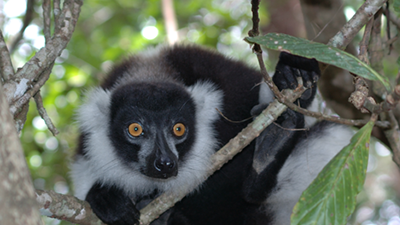In the humid rainforest of Madagascar, 14 threatened species of lemurs, found only on the island will soon be able to breathe a little easier. A corridor of forest that stretches along the eastern coast of the island called the Ankeniheny-Zahamena Corridor (CAZ) covers approximately 425,000 hectares. CAZ is a region of rich biological diversity and home to hundreds of local Malagasy communities. The diverse forests provide essential ecosystem services upon which local people rely for their daily subsistence, but they are under pressure from slash-and-burn agriculture, illegal logging and other unsustainable practices.
By protecting these forests and by focusing on alternative livelihoods, it has been possible to see the link between healthy ecosystems and human well-being. With the fall in deforestation, there has been a significant reduction in carbon emissions. A project is now being developed that will bring monetary benefits to the community for protecting these forests.
“I switched part of my farming to native species as part of the biodiversity restoration project in the Mantadia-Vohidrazana corridor,”, said Justin Lemiaraka, farmer in the Andasibe community. “In return, with the support of the World Bank and National Association of Environmental Action ANAE, we set up a fish farm with 300 square meter ponds stocked. After my first harvest, I bought a radio which our family had dreamed of for years.”
Hotbed for Biodiversity
The CAZ has long been regarded as one of Madagascar’s most precious resources in terms of biodiversity. Over 2,043 species of plants have been identified in its forests, 85% of which are endemic. Also, 30 other species of mammals inhabit the corridor, in addition to 129 species of amphibians and 89 bird species. But the animals that are perhaps best identified with Madagascar are the lemurs, of which there are 101 species on the island. Fourteen lemur species in CAZ are threatened with extinction as their natural habitat slowly disappears due to deforestation from traditional slash and burn agriculture. The communities living in the forests face hardships due to dwindling natural resources on which they depend for their subsistence.
Carbon Credits for Protecting Forests
A project is being designed to protect 370,032 hectares of rainforest by linking the Zahamena national park, the Manongarivo special reserve and the Mantadia national park in eastern Madagascar. This voluntary effort, spear-headed by the Ministry of Environment and Forestry (French), Conservation International, and the World Bank’s BioCarbon Fund, aims to reduce emissions from deforestation and forest degradation (REDD) and will provide Verified Emissions Reductions (or carbon credits) that can be sold to finance the future activities of the project and help the local population adapt to the effects of climate change while improving their livelihoods.


